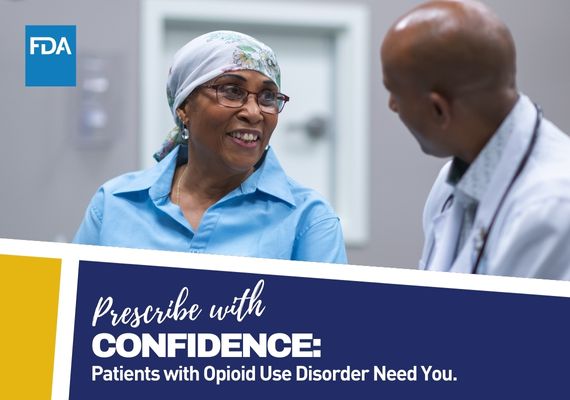The website will be down for maintenance from 6:00 a.m. to noon CDT on Sunday, June 30.
Prescribe with Confidence: Patients with OUD Need You
Information provided by U.S. Food and Drug Administration
A new nationwide campaign from the U.S. Food and Drug Administration’s Center for Drug Evaluation and Research seeks to help primary care clinicians take steps to address the overdose crisis.
There are a lot of people who need or want treatment for opioid use disorder (OUD) but have not received any.1 Many may not be able to access specialty care for this purpose. However, primary care prescribers treating other chronic health conditions are in a key position to prescribe medications for OUD (MOUD) for people who may benefit. Research shows that treatment of OUD is most effective when medications are used.2-6
The FDA’s campaign “Prescribe with Confidence: Patients with Opioid Use Disorder Need You” gives health care professionals including physicians, physician assistants, and nurse practitioners information about:
- Screening for and diagnosing opioid use disorder.
- How to support collaborative treatment decision-making with patients who have OUD, including the use of medications for OUD.
A DATA waiver (X-waiver), long considered a barrier preventing health care professionals from prescribing buprenorphine, is no longer required. That means more clinicians in a variety of primary care practice settings can now prescribe these medications to treat OUD (sometimes also called medication-assisted treatment).
Primary care clinicians can work together with patients to manage care for OUD in the same way they collaborate to manage asthma, diabetes, or hypertension. Treatment of OUD reduces opioid misuse, and people receiving OUD treatment have lower risks of overdose, return-to-use, and death compared with those receiving no treatment.5,7
The “Prescribe with Confidence” campaign provides information and resources for primary care clinicians who are currently prescribing MOUD or are interested in getting started. Many prescribers find that after they start with one or two patients, prescribing medication for opioid use disorder is easier than they thought.
Evidence-based supports, trainings, mentoring, reference guides, and peer-to-peer connections are available to help health care professionals who are currently prescribing these medications or hope to start.
Medications for opioid use disorder can save lives. Visit www.fda.gov/prescribewithconfidence to learn more or download a handout with more information.
REFERENCES
- Jones, C. M., Han, B., Baldwin, G. T., Einstein, E. B., & Compton, W. M. (2023). Use of Medication for Opioid Use Disorder Among Adults With Past-Year Opioid Use Disorder in the US, 2021. JAMA network open, 6(8), e2327488. https://jamanetwork.com/journals/jamanetworkopen/fullarticle/2807964.
- Medications for Opioid Use Disorder Save Lives, Consensus Study Report. National Academies of Sciences, Engineering, and Medicine. (2019). https://nap.nationalacademies.org/catalog/25310/medications-for-opioid-use-disorder-save-lives.
- National Drug Control Strategy. The White House Executive Office of the President, Office of National Drug Control Policy. (2022). https://www.whitehouse.gov/wp-content/uploads/2022/04/National-Drug-Control-2022Strategy.pdf.
- SAMHSA Overdose Prevention and Response Toolkit. Substance Abuse and Mental Health Services Administration. (2024). https://store.samhsa.gov/sites/default/files/overdose-prevention-response-toolkit-pep23-03-00-001.
- Medications for Opioid Use Disorder: Treatment Improvement Protocol (TIP) 63. Substance Abuse and Mental Health Services Administration. (2021). https://store.samhsa.gov/sites/default/files/pep21-02-01-002.pdf
- How effective are medications to treat opioid use disorder? National Institute on Drug Abuse. (2021). https://nida.nih.gov/publications/research-reports/medications-to-treat-opioid-addiction/efficacy-medications-opioid-use-disorder.
- Auriacombe, M., Fatséas, M., Dubernet, J., Daulouède, J. P., & Tignol, J. (2004). French field experience with buprenorphine. The American journal on addictions, 13 Suppl 1, S17–S28.
Disclaimer
The posting of sponsored information and content on this page should not be considered an AAFP endorsement or recommendation of the sponsor's products, services, policies, or procedures. The information and opinions expressed on this page are those of the paid sponsors and do not necessarily reflect the view of the AAFP. The AAFP is not responsible for the content of third-party websites linked from this page; moreover, any links on this page to third-party websites where goods or services are advertised are not endorsements or recommendations by the AAFP of the third-party sites, goods, or services.
